#George Barati
Text

0 notes
Text
youtube
2 notes
·
View notes
Video
youtube
Ulysses Kay’s Sinfonia in E: II. Allegro pesante
Performed by George Barati and the Oslo Philharmonic
The Last Dragon (1985) - Leroy achieves “Final Level" and obtains newfound power from within, to defeat his nemesis Sho'nuff.
#blackclassicalmusic#blackclassicalsoundtrack#ulysseskay#thelastdragon#blackhistorymonth#blackclassicalcomposers
1 note
·
View note
Text

On September 9th, 2016, between 20,000 and 60,000 prisoners participated in the largest incarcerated labor strike in American history. The gulf between these two figures, which is 40,000 loud, reflects the unknown conditions of incarcerated experiences. While this action could not have happened without communication within, between, and outside of the prisons involved, such communication is made difficult by the economic and punitive structures that silent prison social networks. This site chronicles the networks that emerged online as prisoners organized for better working and living conditions, focusing in particular on the strike at Michigan’s Kinross Correctional Facility. Ultimately, it suggests that incarcerated communities fill the gaps created by the punitive system in communication and knowledge by reasserting an informal memory of prison resistance, a memory that is expressed as a common heritage with non-incarcerated communities through online social networks.

Image of a Kinross bathroom after riot police violent suppressed the uprising
Integral to organized resistance is effective communication among participants. The American prison system makes communication among incarcerated people and with those on the outside challenging. One way this is achieved is through a privatized phone and email system. Prisons seek out communication companies that will provide the largest “kickbacks.” Instead of offering the most affordable service possible for prisoners, companies are rewarded for charging high prices, which can be as much as 90% of a contract’s value.

Mignon Clyburn, an official at the Federal Communications Commission, refers to this system as, “The greatest, most distressing type of injustice I have ever seen in the communications sector.” In total, the American prison phone industry is worth 1.2 billion dollars. These high costs affect prisoners greatly, who can spend on average $17 for a 15-minute phone call. Keep in mind, too, that prisoners make from $0.86 to $3.45 per day.

Emails can also be costly to prisoners. Michigan’s Kinross Correctional Facility, for instance, uses a stamp system that charges $0.25 per email “page.”
While these high prices limit prisoners’ ability to communicate with the unincarcerated world, they are not the only barrier. The services themselves are faulty and difficult to navigate. Incarcerated people do not have the option of leaving Yelp reviews for GTL, the largest prison communications service. However, people on the outside trying to contact them do. Below are some recent reviews of the company:




I include such a long list of negative reviews from across the country to illustrate the GTL’s consistent problems. Such widespread technical errors and hidden fees frequently delay or prevent prisoners from receiving an email or phone call. While it is possible that this is just benign incompetence on GTL’s part, it seems more likely that this is a predatory system that profits off of silenced “consumers.”
The communications system in American prisons reflects and reinforces the obstacles prisoners face when organizing for change. Systemic change requires large, well-organized resistance movements. Much of the organizing for such movements relies on social media. This is reflected in the hashtags present in movements like #BlackLivesMatter, #ArabSpring, and #MeToo, which all used social media, not only to communicate among protestors, but also to broadcast the unjust conditions that make such movements necessary. Prisoners cannot livestream when prison guards use violence against them, when their living conditions are inhumane, or when the carceral bureaucratic system acts unjustly. This lack of visibility creates a lack of accountability in prisons. It is only in extreme instances where abuse of power is made visible. And even then, there is rarely recourse for the victims.
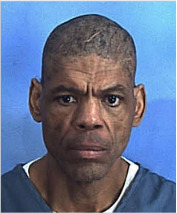
Darren Rainey
For instance, in 2012, Florida prisoner Darren Rainey was murdered by prison guards, who locked him in a hot shower for two hours. The officers, who had external control over the temperature, forced Rainey to stay in the shower as they turned the water to its highest heat setting--180°F. Images of Rainey’s body, which I won’t display here but which can be found online, show that large strips of skin on his back and legs had been burned off. After Rainey’s death, the officers involved argued that the death was accidental and unexplained. The case was then classified, and the DOC ultimately promoted the guards. However, when The Miami Herald made a visit to the prison to investigate, they heard testimony from other prisoners that officers often used this form of punishment on prisoners, citing at least eight incidents in Rainey’s unit alone. Without outside interest in the events of incarcerated experiences, these stories do not get told, as prison employees and administrators cannot be trusted to admit their own wrongdoing, and prisoners have limited ability to speak out.
For this reason, the prison abolition’s presence on social media is significant. It is through social media that I first became invested in prison abolition and reform. Neither I nor my friends have many people close to us who are incarcerated. However, the past decade has seen a resurgence of the prison abolition movement. Thinkers like Angela Davis, Michelle Alexander, and Ava DuVernay are a part of an abolitionist heritage that situates prison injustice, not as marginal to America’s systemic inequality, but as fundamental to it.
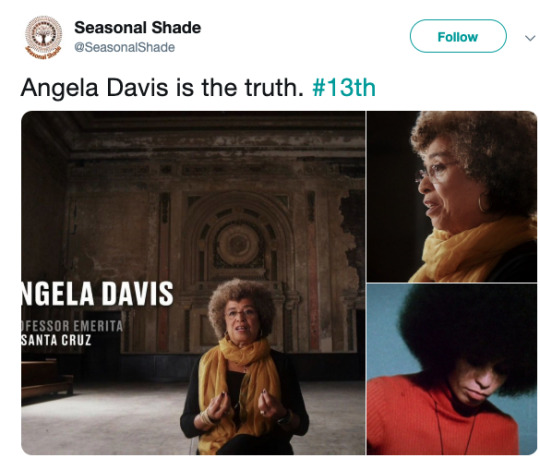
A tweet of Angela Davis in Ava DuVernay’s Netflix documentary, 13th
On my Facebook feed, I saw friends and acquaintances using social media to communicate about prison reform and to facilitate community action. Below are images of this community response, with the names of users kept hidden for privacy.

In this post, a user identifies a relationship between climate and prison justice.

This post from 2018 shows a user tracking a weeks-long protest in a Canadian prison, which she suggests is tied to American economic and civil justice.
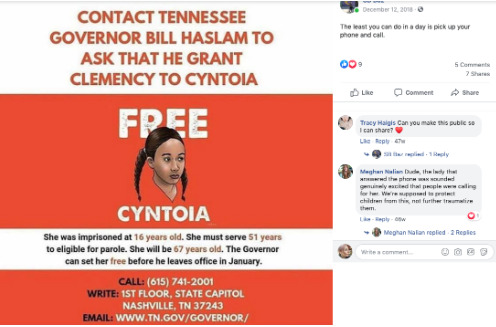
Posters using Facebook as a call to action to support an incarcerated woman. This text begins with a demand to free Cyntoia, offers contact information, and information about her case in one image. Note that seven people shared the image, and others engaged asking clarifying questions. The use of heart emojis and reactions (15 total) suggests a sense of community with Cyntoia Jackson, that the Tennessee prisoner is a part of a larger collective.
Here, a Facebook event is made to facilitate an action. Note the sense of solidarity and community in the image--hand prints and the words “Until we are all free None of us are free.”
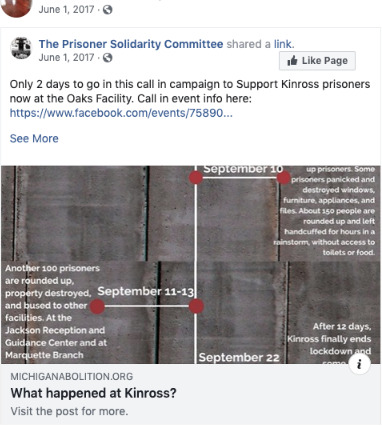
Here, information about the events of the Kinross prisoner strike are shared and tied with an action to call-in.
This image from 2016 reflects a similar sentiment, with the hashtag #UntilAllAreFree and shows a photo of a Kinross prisoner. Note that the image has three shares and that the reacts are angry and sad emojis. I wonder if the directness of this post and its lack of narrative invites more angry/sad emojis than feelings of communal love.
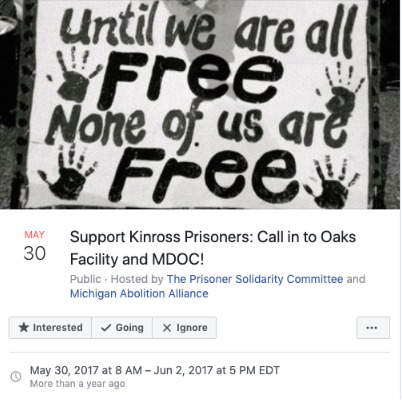

Here, people use the comment section to update each other on the phone calls they made. Note the user who says, “I’m relatively new to Michigan...but I’ll call at eight & tell my friends to do the same!” This reaction illustrates the sense of solidarity non-incarcerated people feel with incarcerated struggles, even when they are not from the region where the struggle takes place. Also, note the heart sticker, which again suggests a sense of communal bonds.
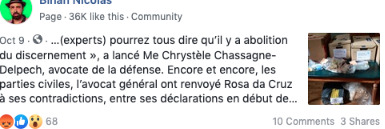
A French user posts in solidarity with an American prison movement.
Finally, I’d like to examine the role of memory in prison resistance and in the Kinross uprising. In particular, the Attica prison uprising is invoked often as a symbol of resistance and as a reminder of the need to continue fighting. Note the post below, which references the movement, saying, “We remember #Attica!”

The Attica prison uprising was a 1971 movement in a New York prison. After prison guards killed George Jackson at the San Quentin State Prison, over 1,000 Attica Prison inmates seized control of their facility, taking 42 staff hostage.
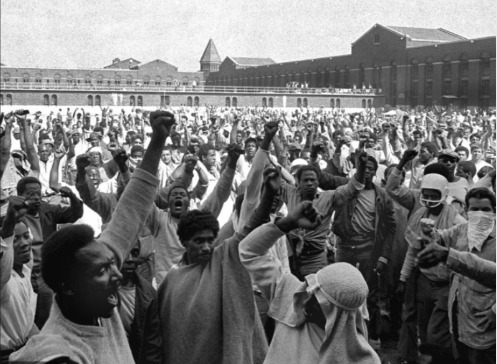
Image from the Attica uprising
Riot police were brought in, and after four days of protests, the 28 of the rioters’ demands were met. However, the riot also resulted in 48 deaths, 33 of which were inmates.

Many articles and social media posts commenting on modern resistance movements reference this uprising, using terms like “remembering” and “looking back” in order to understand emerging movements. Two years after the Kinross protest. Note the “We remember #Attica!” comment above.
A 2018 radio podcast by Rustbelt Abolition Radio uses this terminology to frame its interview with participants in the Kinross labor stoppage (link below).
(via Specters of Attica: Reflections from Inside a Michigan Prison Strike)
In the interview, prisoner Ajhamu Barati explains how and why he participated in the labor strike. Throughout the interview, he identifies the need to read about the past in order to take effective action in the future. The interviewer comments that he often quotes George Jackson, the prisoner whose death sparked the Attica uprising.

To me, this referencing to the past is necessary in the wake of systemic silencing of prison narratives. There seems to be a need to remember what has happened, as the prison-industrial system suppresses communication and asks us to forget the deaths of people like Darren Rainey. In the Rustbelt interview, Barati explains that, “The whole thing is about control: control your movement, control of what you received in here. Because I just received a paper from the San Francisco black national paper and they were talking about the Million Prisoner March that (just) happened August 19th, in Washington D.C. about the human rights and they rejected it. And I asked the counselor about why did you reject it, is that advocating violence? And she just said because it’s speaking about human rights and the conditions of prisoners here. So any time you talk about prisoner conditions, they don’t want the prisons to hear that, they don’t want that kind of news to come in here.”
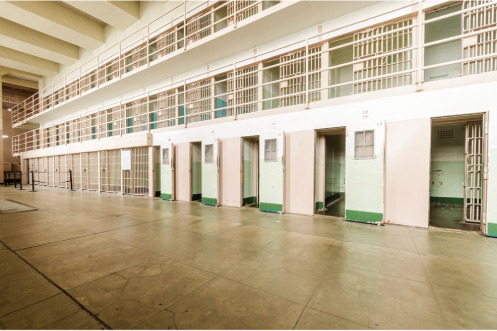
While this silencing created within prisons is disheartening, the living memory forged through people like Barati can challenge that silence. That his sentiments and experiences are echoed by non-incarcerated people through social media suggests that the slow-moving, deep-rooted knowledge of incarcerated memory tied with the speed and interconnectedness of social networking is perhaps forging a shared heritage of resistance. Barati’s closing comments, though not expressed through the language of emoji and reposting of Facebook, iterate the same feeling. He says, “If you control a man’s thoughts, you don’t have to worry about his actions. And we in a psychological warfare so brothers got to start getting a political consciousness they gotta read, they gotta read, and broaden our awareness. Solidarity and love out there to everyone.” While the gaps in communication and knowledge created by the prison system may seek to obscure the oppression experienced by prisoners, it may be through those gaps that memory and resistance persist.
1 note
·
View note
Text

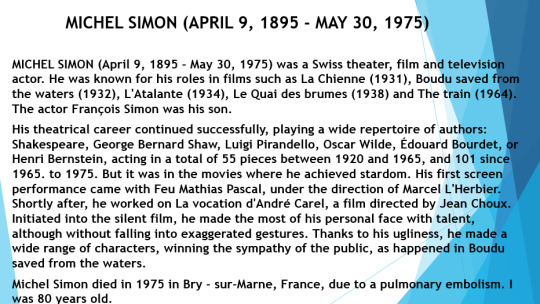




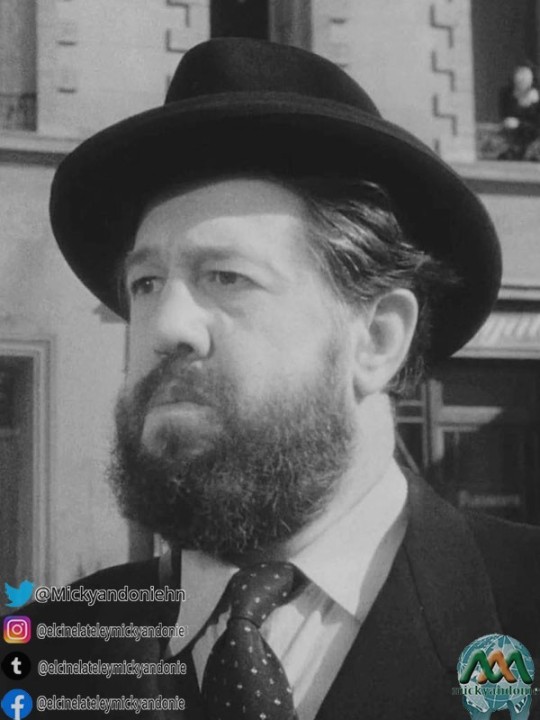
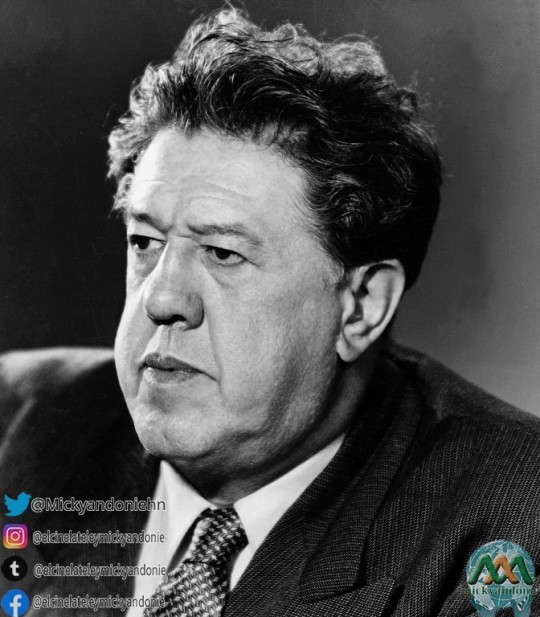
MICHEL SIMON.
Filmography
1924: La Galerie des monstres, by Jaque Catelain and Marcel L'Herbier
1925: La Vocation d'André Carel, by Jean Choux
1925: Feu Mathias Pascal, by Marcel L'Herbier
1926: L'Inconnue des six jours, 6 by René Sti
1927: Casanova, by Alexandre Volkoff
1928: Tire-au-flanc, by Jean Renoir
1928: The Passion of Joan of Arc, by Carl Theodor Dreyer
1929: Pivoine, 7 by André Sauvage
1930: L'Enfant de l'amour, by Marcel L'Herbier
1931: On purge bébé, by Jean Renoir
1931: La Chienne, by Jean Renoir
1931: Baleydier, by Jean Mamy
1931: Jean de la Lune, by Michel Simon (signed by Jean Choux)
1932: Boudu saved from the waters, by Jean Renoir
1933: Miquette et sa mère, by Henri Diamant-Berger, D. B. Maurice and Henri Rollan
1940: La Comédie du bonheur, by Marcel L'Herbier
1941: Tosca, by Carl Koch
1941: Il ré se divertrte, by Mario Bonnard
1942: A Signora dell'Ovest, by Carl Koch
1943: Vautrin, by Pierre Billon
1943: Au Bonheur des Dames, by André Cayatte
1951: La Poison, by Sacha Guitry
1951: Vedettes sans maquillage, by Jacques Guillon
1951: La Cité du midi, by Jacques Baratier
1952: Le Marchand de Venise, by Pierre Billon
1952: Hôtel des Invalides, by Georges Franju
1952: Monsieur Taxi, by André Hunebelle
1952: La Fille au fouet, by Jean Dréville
1955: L'Impossible Monsieur Pipelet, by André Hunebelle
1955: Les Mémoires d'un flic, by Pierre Foucaud
1956: La Joyeuse Prison, by André Berthomieu
1957: Les Trois font la paire, by Sacha Guitry
1957: Un certain monsieur Jo, by René Jolivet
1958: The Bait, by Ladislao Vajda.
0 notes
Text
April 03 in Music History
1569 Birth of composer Giovanni Battista Massarengo.
1617 Birth of composer Antimo Liberati.
1639 Birth of Italian composer Alessandro Stradella in Montefestino.
1649 Birth of composer Joseph-François Salomon.
1682 Birth of composer Johann Valentin Rathgeber.
1751 Birth of composer Jean-Baptiste Lamoyne.
1757 Birth of composer Ferenc Verseghy.
1781 W. A. Mozart makes his adult first public appearance in Vienna for the Tonkünstler-Societät.
1786 FP of Mozart’s Piano Concerto No. 24 in c, K. 491, at the Burgtheater in Vienna.
1825 Birth of composer Adolf Rzepko.
1832 First duo performance of pianist Franz Liszt and Frederic Chopin, in Paris.
1836 Birth of American composer Rigdon McCoy McIntosh.
1850 Birth of Italian tenor Giovanni De Negri in Alessandria, Italy.
1859 Birth of American opera composer Reginald DeKoven in Middletown, CT.
1868 Death of Swedish composer Franz Berwald.
1871 FP in US of Wagner’s ópera Lohengrin in NYC.
1874 Birth of composer Eduardo Sanchez de Fuentes.
1888 Birth of German soprano Tilly De Garmo in Dresden.
1888 Birth of English music critic and writer Sir Neville Cardus.
1889 Birth of Rumanian violinist and composer Grigoras Dinicu in Bucharest.
1895 Birth of Italian-American composer Mario Castelnuovo-Tedesco in Florence.
1897 Death of German composer Johannes Brahms.
1901 Death of British impresario Richard D'Oyly Carte at age 56, in London.
1902 Birth of composer Siguringi Eirikur Hjorleifsson.
1909 Birth of soprano Coba Wackers in Wuppertal.
1911 FP of Jean Sibelius Fourth Symphony, composer conducting.
1913 Birth of composer George Barati.
1917 Birth of composer Tibor Andrasovan.
1918 Birth of composer Louis Applebaum.
1918 Birth of composer Enrique Iturriaga.
1918 Birth of Swedish conductor Sixten Ehrling, in Malmo.
1921 Death of American mezzo-soprano Annie Louise Cary.
1923 Birth of tenor Umberto Borso in La Spezia.
1923 FP of Albert Roussel’s ballet Le Festin de l'araignée ‘The Spider’s Feast’, in Paris.
1924 Birth of tenor Murray Dickey.
1924 Birth of American bass Barr Peterson in Mason City, Iowa.
1925 FP of Gustav Holst’s opera At the Boar’s Head in Manchester.
1926 FP in US America of Sibelius’ Symphony No. 7. Philadelphia Orchestra, Leopold Stokowski conducting.
1928 Birth of Swedish soprano Kerstin Meyer.
1931 FP of Paul Hindemith’s Concert Music. Boston Symphony, commissioned for the orchestra’s 50th anniversary.
1948 Birth of American pianist Garrick Ohlsson in Bronxville, NY.
1950 Death of German composer Kurt Weil at age 50.
1953 Birth of Russian pianist Mikhail Rudy.
1971 Debut of Israeli violinist Pinchas Zukerman in New York City.
1972 Death of American composer, pianist and arranger Ferde Grofe in Santa Monica, CA.
1986 Death of British tenor Peter Pears.
1998 FP of Tan Dun’s Concerto for Six Players. Bang On A Can All-Stars, in Durham, NC.
1999 Death of British composer Lionel Bart.
2004 FP of Samuel Adler´s Piano Concerto No. 3. Roger Creel, Community Orchestra of Weston, conducted by Samuel Adler. Rivers Music School, Weston, MA.
2 notes
·
View notes
Text
youtube
George Barati (1913-1996) - Chant of Light ·
Budapest Symphony Orchestra, Conductor: Laszlo Kovacs
1 note
·
View note
Text
NEWS Beitrag von SEO & Google Marketing - Businesspläne - Finanzierungsvermittlung
New Post has been published on http://www.igg-gmbh.de/civis-medienpreis-2017-13-programme-in-berlin-ausgezeichnet/
CIVIS Medienpreis 2017 - 13 Programme in Berlin ausgezeichnet
nn n n n
Berlin (ots) – Dreizehn europäische Radio-, Film-, Fernseh- und Internetprogramme sind am Donnerstagabend im Auswärtigen Amt in Berlin mit dem renommierten CIVIS Medienpreis für Migration, Integration und kulturelle Vielfalt in Europa ausgezeichnet worden. Am Wettbewerb 2017 nahmen insgesamt 783 Programme aus 24 EU-Staaten und der Schweiz teil.
Die festliche Preisverleihung und TV-Gala wird in der ARD/Das Erste und in mehreren europäischen Fernsehprogrammen übertragen (siehe Sendetermine).
Bundespräsident Frank-Walter Steinmeier, der Präsident des Europäischen Parlaments, Antonio Tajani, und Bundesaußenminister Sigmar Gabriel sind Schirmherren des CIVIS Medienpreises 2017.
Auszeichnungen 2017.
Mit dem CIVIS Medienpreis 2017 wurden Programme von ARD, BR, Deutschlandradio, France Télévisions, HR, MDR, NDR, RAI 3, SRF, WDR und der Hamburg Media School prämiert. Die Preise sind dotiert. Bekannt waren bereits der Preisträger des \”European Young CIVIS Media Prize<\” \”Different Bayern\” von Matthias Koßmehl (HMS/BR), und die Preisträger der \”CIVIS Sonderpreise \”Fußball und Integration\”\”, \”Ayham – mein neues Leben\” von Ilona Stämpfli, Marek Beles (TV), \”Bis zum letzten Atemzug\” von Agnese Franceschini, Tom Mustroph (Radio) und \”together2016 – die Integrationskraft des Fußballs\” von Stephan Hermann (Online). Der CIVIS Sonderpreis wird vom Deutschen Fußball-Bund (DFB) mit unterstützt. Der CIVIS Kinopreis geht als Publikumspreis an das Spielfilmdrama \”Vor der Morgenröte\” der X FILME CREATIVE POOL / IDÈALE AUDIENCE / MAHA PRODUCTIONS / DOR FILM. Ausgezeichnet wurden Maria Schrader (Regie) sowie Stefan Arndt, Uwe Schott, Pierre-Olivier Bardet, Danny Krausz, Kurt Stocker, Denis Poncet (Produktion).
Prominente Gäste bei der CIVIS TV-Gala
Die Integrationsbeauftragte der Bundesregierung, Staatsministerin Aydan Özoguz, und die Menschenrechtsbeauftragte der Bundesregierung, Bärbel Kofler, nahmen an der festlichen Preisverleihung im Auswärtigen Amt teil. Mit ihnen die ARD-Vorsitzende und MDR-Intendantin Karola Wille, WDR-Intendant Tom Buhrow, SRG-Generaldirektor Roger de Weck, der Intendant des Deutschlandradios Willi Steul, der CEO der Freudenberg Group Mohsen Sohi, Minu Barati-Fischer von der Allianz Deutscher Produzenten, BR-Hörfunkdirektor Martin Wagner, WDR-Fernsehdirektor Jörg Schönenborn, WDR-Hörfunkdirektorin Valerie Weber, WDR-Verwaltungsdirektorin Katrin Vernau, der Leiter der Recherchekooperation von NDR, WDR, SZ Georg Mascolo, DFB-Vizepräsident Eugen Gehlenborg, DFB-Mediendirektor Ralf Köttker. Ebenso die TV-Moderatorinnen und Moderatoren Ingo Zamperoni (ARD), Frank Elstner (ARD), Anja Reschke (NDR), Dunja Hayali (ZDF), Siham El-Maimouni (WDR), Cherno Jobatey (ZDF), die Tatort-Kommissare Harald Krassnitzer (ORF) und Miroslav Nemec (BR), Filmregisseurin Buket Alakus, Michael Loeb (WDR mediagroup), Michael Radix (CIVIS Medienstiftung) u.a..
Die Preisträgerinnen und Preisträger (Überblick)
Den europäischen \”CIVIS Fernsehpreis im Bereich Magazine\” (kurze Programme bis zehn Minuten) erhielten Ben Bolz und Johannes Edelhoff für ihren Beitrag im ARD-Politikmagazin PANORAMA \”Alternative für die Politik: Emotionen statt Fakten\” (Norddeutscher Rundfunk).
Der europäische \”CIVIS Fernsehpreis im Bereich Information (non fictional)\” ging an Domenico Iannacone und Luca Cambi für ihre Reportage \”Lontano Dagli Occhi / Aus den Augen …\” (RAI 3).
Den europäischen \”CIVIS Fernsehpreis im Bereich Unterhaltung (fictional)\” erhielten Françoise Charpiat und Aude Marcle für ihren Fernsehfilm \”Ne m\’abandonne pas …/ Gib mich nicht auf …\” (France Télévisions).
Mit dem europäischen \”CIVIS Radiopreis im Bereich Lange Programme (ab sechs Minuten)\” wurden sowohl Marina Frenk und Stefan Kanis für ihr Hörspiel \”Jenseits der Kastanien\” (MDR Kultur – Das Radio) ausgezeichnet, als auch Angela Fitsch, Ulrich Sonnenschein, Claudia Sautter, Karen Fuhrmann, Martin Hürtgen für ihre tagesaktuelle Hintergrundsendung \”Grenzen der Aufklärung – Rechte Gewalt und die Justiz\” (hr2-Kultur Der Tag). Die CIVIS Jury benannte in diesem Bereich zwei Preisträger.
Der europäische \”CIVIS Radiopreis im Bereich kurze Programme (bis sechs Minute)\” ging an Anna Osius für Teil 6 ihrer Serie \”Leben unter dem IS\” (WDR 5 Morgenecho).
Die europäischen \”CIVIS Sonderpreise im Bereich \”Fußball und Integration\”\” erhielten Ilona Stämpfli und Marek Beles für ihre Fernseh-Dokumentation \”Ayham – mein neues Leben\” (Schweizer Radio und Fernsehen), Agnese Franceschini und Tom Mustroph für das Hörfunkfeature \”Dok 5 – Das Feature: Bis zum letzten Atemzug\” (Westdeutscher Rundfunk, Deutschlandradio) und Stephan Hermann, vertretungsberechtigt für das Video-Webangebot \”Together2016\” (CoupDoeil Productions).
Der europäische \”CIVIS Online Medienpreis im Bereich Webangebote\” ging an Ole Leifels, vertretungsberechtigt für die Webseite www.kein-raum-fuer-rechts.de (BAFF Filmproduktion, Kubikfoto3).
Den europäischen \”CIVIS Online Medienpreis im Bereich Webvideos\” erhielt Sylvia Griss, vertretungsberechtigt für das Video \”Ramo: Soll ich zurück nach Syrien?\” (Bayerischer Rundfunk, TV-Kultur-Sendung \”Capriccio\”).
Mit dem \”European Young CIVIS Media Prize\” wurde Matthias Koßmehl ausgezeichnet für seinen Kurzfilm \”Different Bayern\” (Hamburg Media School, Bayerischer Rundfunk).
Der CIVIS Medienpreis wird seit 30 Jahren für Programmleistungen im Radio, Film, Fernsehen und seit 2010 im Internet vergeben, die das friedliche Zusammenleben in der europäischen Einwanderungsgesellschaft fördern.
Hier die Jurybegründungen zum Download: http://ots.de/YerlN
Sendetermine: n 02.06.2017 ARD/Das Erste, 0.50 - 2.05 Uhr n 01.06.2017 ORF III Fernsehen, 23.30 - 0.45 Uhr n 02.06.2017 tagesschau24, 23.30 - 0.45 Uhr n 02.06.2017 WDR Fernsehen, 08.20 - 9.35 Uhr n 11.06.2017 3sat, 10.05 - 11.20 Uhr n ARD-Hörfunk und Deutsche Welle TV berichten aktuell.
Pressekontakt:
CIVIS Medienstiftung für Integration und kulturelle Vielfalt in
nEuropa
nMichael Radix
nTel.: 0221-2775870
[email protected] | www.civismedia.eu
n
0 notes
Text
youtube
George Barati (1913-1996) - Chamber Concerto: II. Andante tranquillo ·
Various Artists · Baroque Chamber Players of Indiana ··
Philadelphia Orchestra · Eugene Ormandy
1 note
·
View note
Text
youtube
George Barati (1913-1996) : Concerto per violoncello e orchestra (1950)
I. Andante espansivo II. Scherzando (Insouciantly) III. Adagio - Allegro non troppo e grazioso
Bernard Michelin, cello
London Philharmonic Orchestra diretta da George Barati
1 note
·
View note